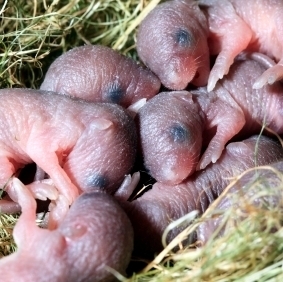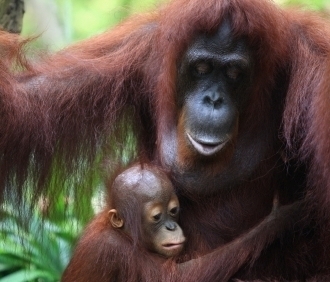Human Evolution: Why Babies Sleep As They Do
Human Evolution: Why Babies Sleep As They Do
Humans as Mammals – and Unusual Primates
Humans are mammals—and more specifically, primates. Like all mammals, we are warm-blooded, give birth to live young, and feed our infants with milk produced by the mother. But when we look more closely at the type of mammal and primate we are, things get interesting.
Mammal babies generally fall into one of two categories:

Altricial species (like mice, rabbits, cats, and dogs) give birth to litters of highly dependent, underdeveloped babies. These young are usually blind, hairless, and unable to move around or cling to a parent. They’re kept safe in nests or dens, sleep most of the time, and feed infrequently on high-fat milk that takes longer to digest (Martin, 1992)

Precocial species (such as deer, horses, sheep, monkeys, and apes) give birth to just one or two well-developed babies at a time. These infants can often see, walk, or cling shortly after birth and stay close to their mothers as they move about. They feed frequently—on demand—on low-fat, high-sugar milk that’s easy to digest and fuels alertness and activity (Skibiel et al., 2013). Mothers in precocial species don’t typically construct nests, rather they adopt a carry/follow infant care strategy (Lozoff and Brittenam, 1979).
Humans, like all other primates, fit into the group of precocial species and our infants are typically born singly or in pairs with their senses well developed and ready to cry upon separation from their mother (Small, 1998). However, when compared our closest relatives of chimpanzees, bonobos, gorillas, orangutans, the human species have the most relatively underdeveloped brains at birth (Martin, 1992). At birth, a human baby’s brain is just 25% the size of an adult’s, while newborn chimps are born with brains around 50% adult size (Small 1998; Hrdy 1999).
Human babies are often described as “secondarily altricial”—meaning they show a blend of altricial and precocial traits (Gómez-Robles et al., 2024). Compared to other primates, human newborns are unusually helpless thanks to our relatively underdeveloped brains. Human babies can’t cling to a parent, regulate their own temperature well, or even hold up their heads (Martin, 1992). And unlike other primate babies, they need round-the-clock care just to survive.
Helpless Babies
Much of human brain growth happens after birth—requiring prolonged, close parental care. After birth, our brain growth and neurological development takes much longer than other primates (Gómez-Robles et al., 2024) and human babies are born prior to developing the coordination to cling to or follow their mothers, again uniquely helpless. Recognition of this unique helplessness wasn’t identified by zoologists or anthropologists as a key feature of the human species until the middle of the twentieth century, which has since informed a greater understanding that such prolonged infant and childhood development has contributed to our species’ success (Ball, 2025).
Understanding the Research
We provide the research and evolutionary theories behind our infant sleep content to help you understand and inform safe sleep practices with your baby. As a research-based site, BASIS prioritises bringing the research to you to inform your decisions. There are two theories behind why babies are born so helpless:
‘Big brain can’t fit!’
The first widely adopted theory of why humans are born so uniquely helpless with relatively under-developed brains was that a fully developed human brain wouldn’t fit through the birth canal.
As humans evolved to walk upright (bipedally), our pelvises became narrower. At the same time, our brains grew larger. The idea was that a wider birth canal would make walking inefficient, so evolution struck a balance between walking upright and childbirth. This created a tight fit between baby and birth canal. To be born at all, human babies must exit the womb much earlier in their developmental timeline than other primates (Rosenberg & Trevathan 2002).
‘Mother’s body can’t support!’
For years, scientists believed that the size of a baby’s head and the shape of a woman’s pelvis, known as the “obstetric dilemma”, explained why human babies are born relatively early and underdeveloped compared to other mammals.
However, recent research challenges this view. Anthropologist Holly Dunsworth and colleagues (2012) proposed an alternative theory: the energetics of gestation and growth (EGG) hypothesis. This theory suggests that the limit on pregnancy length isn’t due to the size of the birth canal, but rather the amount of energy a mother’s body can provide for her infant during pregnancy. By around nine months, a developing foetus requires more energy than the mother’s body can sustainably supply. At this point, birth becomes necessary—not because the baby’s head is too big to fit, but because the mother’s metabolism has reached its limit.
In other words, this theory suggests that babies are born when they are because mothers physically can’t meet their growing energy needs any longer.
Golden Hour and Skin to Skin
The reason you may hear about the importance of skin to skin contact, particularly after birth, is because both the mother and baby are primed to have oxytocin (the ‘love’ hormone) flood through their system, supporting their initial bond and maternal confidence (Phillips, 2013). Uninterrupted skin to skin contact has been evidenced to help infants have better respiratory function, temperature regulation, and reduces crying (Phillips, 2013).
As an example of our mammalian roots, human infants instinctually demonstrate very specific behaviours in the hour after birth if placed on their mother’s chest. These instinctual movements, referred to as Widström’s nine stages, helps the infant learn breastfeeding supportive behaviour, see below (Widström et al., 2019):
Frequent Feeding and Sleep Disruption
Like other primates, human milk is low in fat and protein but rich in sugars (especially lactose), which provide energy for rapid brain growth (Trevathan and Rosenberg, 2016). But unlike species that leave their young for long periods, human milk is designed for babies who feed frequently and are kept in close contact with their caregiver (Jelliffe and Jelliffe, 1978). This high sugar low fat breastmilk results in frequent feedings – day and night.
Modern formula, which is designed to mimic breastfeeding with a similar high-sugar low-fat constitution, also results in caretakers regularly feeding their baby throughout the night. There are some nuances between breastfed and formula-fed infant sleep habits, learn more here.
This approach to infant care, where parents are close and responsive to infants throughout the night, has been argued to be typical in ancestral environments and is still the norm in traditional and non-western societies. Mothers remain in near-constant physical contact with their babies: carrying them during the day, sleeping beside them at night, and feeding them on demand (Ball 2006a). These practices aren’t just cultural—they align closely with what human infants are biologically adapted for.
.
Last Reviewed: July 2025
